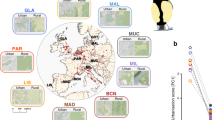Abstract
The bioacoustic attributes of vocalisations made by birds in urban environments often differ markedly from those of rural conspecifics. Whether such differences are result from genetic divergence between urban and rural populations, or from plasticity or cultural evolution of song remains poorly understood. Silvereyes (Zosterops lateralis) show evidence of acoustic adaptation to urban noise, modifying both their songs and calls in cities when compared to rural areas. We investigated whether these differences were associated with corresponding morphological and neutral genetic differences. Across six pairs of geographically separate urban and rural populations, all morphological traits measured were similar. Furthermore, genetic analyses of variation at nine microsatellite loci revealed high levels of genetic connectivity between populations, and similar levels of heterozygosity in both habitat types. Consistent directional shifts in song attributes of city birds across large geographic areas thus do not appear to be accompanied by associated morphological or neutral genetic divergence.



Similar content being viewed by others
References
Badyaev AV, Young RL, Oh KP, Addison C (2008) Evolution on a local scale: developmental, functional, and genetic bases of divergence in bill form and associated changes in song structure between adjacent habitats. Evolution 62:1951–1964
Balloux F, Lugon-Moulin N (2002) The estimation of population differentiation with microsatellite markers. Mol Ecol 11:155–165
Blondel J (2007) Coping with habitat heterogeneity: the story of Mediterranean blue tits. J Ornithol 148:3–15
Cardoso GC, Atwell JW (2011) Directional cultural change by modification and replacement of memes. Evolution 65:295–300
Catterall CP, Wyatt WS, Henderson LJ (1982) Food resources, territory density and reproductive success of an island silvereye population Zosterops lateralis. Ibis 124:405–421
Chace JF, Walsh JJ (2006) Urban effects on native avifauna: a review. Landsc Urban Plan 74:46–69
Chan K, Kikkawa J (1997) Short communication: a silvereye Dilemma: to migrate or not to migrate? Emu 97:91–93
Clegg SM, Degnan SM, Moritz C, Estoup A, Kikkawa J, Owens IP (2002) Microevolution in island forms: the roles of drift and directional selection in morphological divergence of a passerine bird. Evolution 56:2090–2099
Cynx J, Bean NJ, Rossman I (2005) Testosterone implants alter the frequency range of zebra finch songs. Horm Behav 47:446–451
Degnan SM, Robertson BC, Clegg SM, Moritz CC (1999) Microsatellite primers for studies of gene flow and mating systems in white-eyes (Zosterops). Mol Ecol 8:159–160
Derryberry EP (2009) Ecology shapes birdsong evolution: variation in morphology and habitat explains variation in white-crowned sparrow song. Am Nat 174:24–33
DiBattista J (2008) Patterns of genetic variation in anthropogenically impacted populations. Conserv Genet 9:141–156
Edelaar P, Benkman CW (2006) Replicated population divergence caused by localized coevolution? A test of three hypotheses in the red crossbill-lodgepole pine system. J Evolut Biol 19:1651–1659
Evans KL, Gaston KJ, Frantz AC, Simeoni M, Sharp SP, McGowan A, Dawson DA, Walasz K, Partecke J, Burke T, Hatchwell BJ (2009) Independent colonization of multiple urban centres by a formerly forest specialist bird species. Proc R Soc B Biol Sci 276:2403–2410
Evans KL, Newton J, Gaston KJ, Sharp SP, McGowan A, Hatchwell BJ (2012) Colonisation of urban environments is associated with reduced migratory behaviour, facilitating divergence from ancestral populations. Oikos 121:634–640
Excoffier L, Laval G, Schneider S (2005) Arlequin (version 3.0): an integrated software package for population genetics data analysis. Evolut Bioinform Online 1:47–50
Frentiu FD, Lange CL, Burke T, Owens IPF (2003) Isolation of microsatellite loci in the Capricorn silvereye, Zosterops lateralis chlorocephalus (Aves: Zosteropidae). Mol Ecol Notes 3:462–464
Griffiths R, Double MC, Orr K, Dawson RJ (1998) A DNA test to sex most birds. Mol Ecol 7:1071–1075
Halfwerk W, Slabbekoorn H (2009) A behavioural mechanism explaining noise-dependent frequency use in urban birdsong. Anim Behav 78:1301–1307
Higgins PJ, Peter JM, Cowling SJ (2006) Boatbill to starlings: handbook of Australian, New Zealand and antarctic birds, vol 7. Oxford University Press, Melbourne
Jost LOU (2009) D vs. GST: response to Heller and Siegismund (2009) and Ryman and Leimar (2009). Mol Ecol 18:2088–2091
Kikkawa J (1987) Social relations and fitness in silvereyes. In: Ito Y, Brown J, Kikkawa J (eds) Animal societies—theories and facts. Japan Scientific Press, Tokyo, pp 253–266
Kikkawa J, Wilson J (1983) Breeding and dominance among the Heron Island Silvereyes Zosterops lateralis chlorocephala. Emu 83:181–198
Laitinen J, Samarut J, Hölttä E (1994) A nontoxic and versatile protein salting-out method for isolation of DNA. Biotechniques 17:316–322
Leader N, Geffen E, Mokady O, Yom-Tov Y (2008) Song dialects do not restrict gene flow in an urban population of the orange-tufted sunbird, Nectarinia osea. Behav Ecol Sociobiol 62:1299–1305
Luther D, Baptista L (2010) Urban noise and the cultural evolution of bird songs. Proc R Soc Lond B 277:469–473
MacDougall-Shackleton EA, MacDougall-Shackleton SA (2001) Cultural and genetic evolution in mountain white-crowned sparrows: song dialects are associated with population structure. Evolution 55:2568–2575
Marler P (2004) Bird calls: their potential for behavioral neurobiology. Ann N Y Acad Sci 1016:31–44
McCarthy MA (2007) Bayesian methods for ecology. University Press, Cambridge
Meirmans PG (2006) Using the AMOVA framework to estimate a standardized genetic differentiation measure. Evolution 60:2399–2402
Meirmans PG, Van Tienderen PH (2004) Genotype and genodive: two programs for the analysis of genetic diversity of asexual organisms. Mol Ecol Notes 4:792–794
Nemeth E, Brumm H (2010) Birds and anthropogenic noise: are urban songs adaptive? Am Nat 176:465–475
Partecke J, Gwinner E (2007) Increased sedentariness in European blackbirds following urbanization: a consequence of local adaptation? Ecology 88:882–890
Partecke J, Van’t Hof T, Gwinner E (2004) Differences in the timing of reproduction between urban and forest European blackbirds (Turdus merula): result of phenotypic flexibility or genetic differences? Proc R Soc B 271:1995–2001
Partecke J, Gwinner E, Bensch S (2006) Is urbanisation of European blackbirds (Turdus merula) associated with genetic differentiation? J Ornithol 147:549–552
Patricelli GL, Blickley JL (2006) Avian communication in urban noise: causes and consequences of vocal adjustment. Auk 123:639–649
Patten MA, Rotenberry JT, Zuk M (2004) Habitat selection, acoustic adaptation, and the evolution of reproductive isolation. Evolution 58:2144–2155
Podos J, Southall JA, Rossi-Santos MR (2004) Vocal mechanics in Darwin’s finches: correlation of beak gape and song frequency. J Exp Biol 207:607–619
Potvin DA, Parris KM, Mulder RA (2011) Geographically pervasive effects of urban noise on frequency and syllable rate of songs and calls in silvereyes (Zosterops lateralis). Proc R Soc B Biol Sci 278:2464–2469
Raymond M, Rousset F (1995) GENEPOP (version 1.2): population genetics software for exact tests and ecumenicism. J Hered 86:248–249
Rice WR (1987) Speciation via habitat specialization: the evolution of reproductive isolation as a correlated character. Evolut Ecol 1:301–314
Riede T, Suthers RA, Fletcher NH, Blevins WE (2006) Songbirds tune their vocal tract to the fundamental frequency of their song. Proc Natl Acad Sci 103:5543–5548
Ripmeester EA, Kok JS, van Rijssel JC, Slabbekoorn H (2010) Habitat-related birdsong divergence: a multi-level study on the influence of territory density and ambient noise in European blackbirds. Behav Ecol Sociobiol 64:409–418
Rousset F (2008) Genepop’007: a complete re-implementation of the genepop software for Windows and Linux. Mol Ecol Resour 8:103–106
Slabbekoorn H, Ripmeester EA (2008) Birdsong and anthropogenic noise: implications and applications for conservation. Mol Ecol 17:72–83
Slabbekoorn H, Smith TB (2002a) Bird song, ecology and speciation. Philos Trans R Soc Lond B Biol Sci 357:493–503
Slabbekoorn H, Smith TB (2002b) Habitat-dependent song divergence in the little greenbul: an analysis of environmental selection pressures on acoustic signals. Evolution 56:1849–1858
Spiegelhalter D, Thomas A, Best N, Lunn D (2006) OPENBUGS user manual version 220. MRC Biostatistics Unit, Cambridge
Vangestel C, Mergeay J et al (2011) Spatial heterogeneity in genetic relatedness among house sparrows along an urban–rural gradient as revealed by individual-based analysis. Mol Ecol 20(22):4643–4653
Yoktan K, Geffen E, Ilany A, Yom-Tov Y, Naor A, Leader N (2011) Vocal dialect and genetic subdivisions along a geographic gradient in the orange-tufted sunbird. Behav Ecol Sociobiol 65:1389–1402
Acknowledgments
We thank three anonymous reviewers for helpful comments improving the manuscript. We thank J. Kruckel for field assistance, G. Fry, A. Leishman, D. Paton, D. Williams, E. Woehler, R. Fuller, and A. Fletcher for assistance in locating and banding, the Australian National Botanic Gardens (ACT), Namadgi National Park (ACT), Glenorchy City Council (Tas), Brisbane City Council (Qld), Munghorn Gap Nature Reserve (NSW), Kogarah City Council (NSW), Darebin City Council (Vic) and Darebin Parklands Association (Vic) for permission to conduct work on their lands.
Ethical note
Procedures were undertaken with the approval of the following agencies: Animal Ethics Committee at the University of Melbourne, Director-General’s Animal Care and Ethics Committee at the NSW Department of Primary Industries, and Wildlife Ethics Committee at the SA Department for Environment and Heritage.
Author information
Authors and Affiliations
Corresponding author
Electronic supplementary material
Below is the link to the electronic supplementary material.
10682_2012_9591_MOESM2_ESM.pdf
Figure S1. Mean measurements of head-bill length, wing length, tarsus length, tail length and mass of rural and urban silvereyes, grouped by geographic area (indicated on map). Error bars represent standard deviation. (PDF 999 kb)
Rights and permissions
About this article
Cite this article
Potvin, D.A., Parris, K.M. & Mulder, R.A. Limited genetic differentiation between acoustically divergent populations of urban and rural silvereyes (Zosterops lateralis). Evol Ecol 27, 381–391 (2013). https://doi.org/10.1007/s10682-012-9591-1
Received:
Accepted:
Published:
Issue Date:
DOI: https://doi.org/10.1007/s10682-012-9591-1




